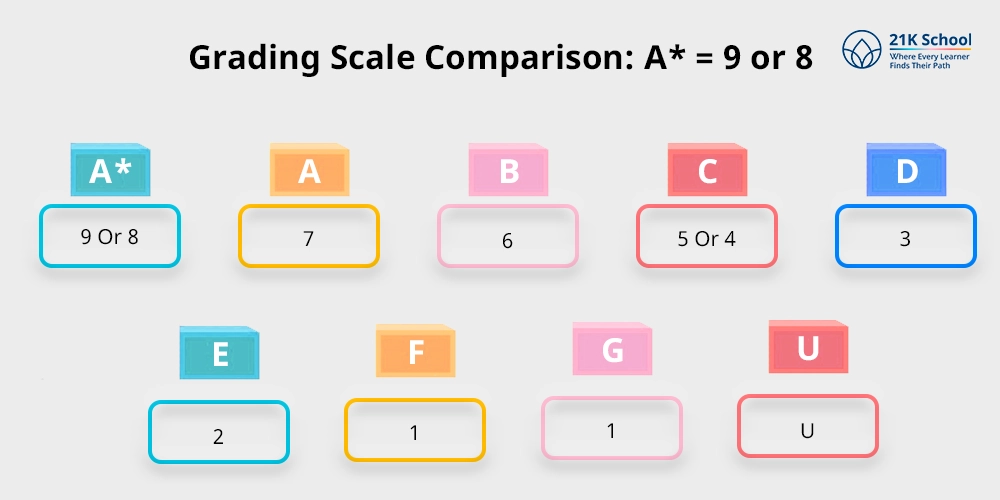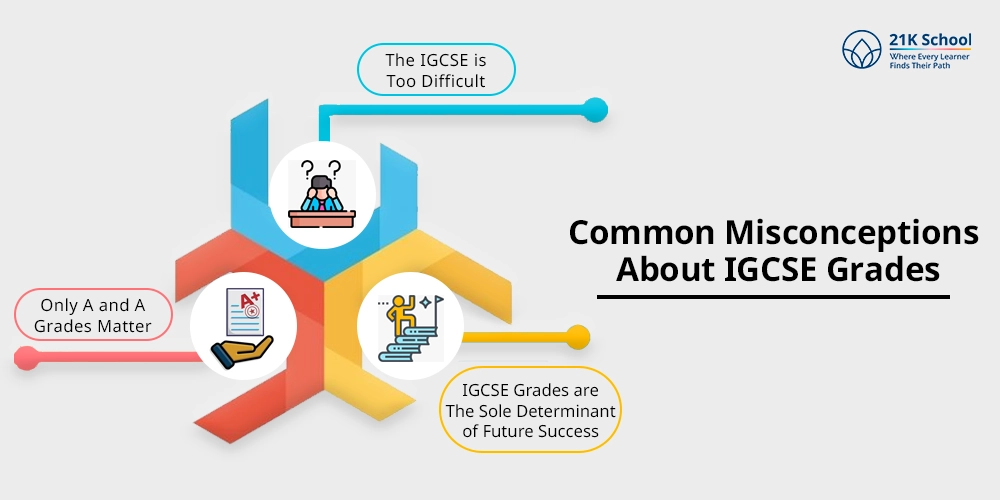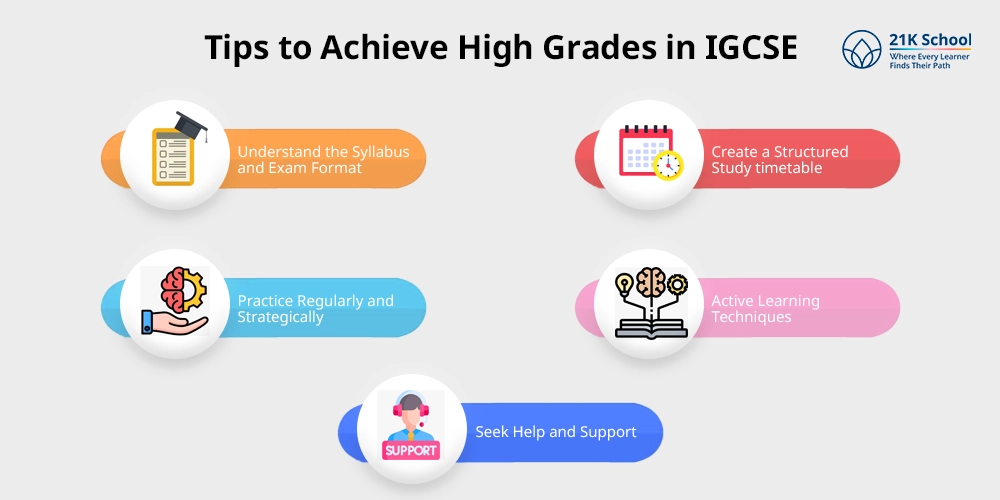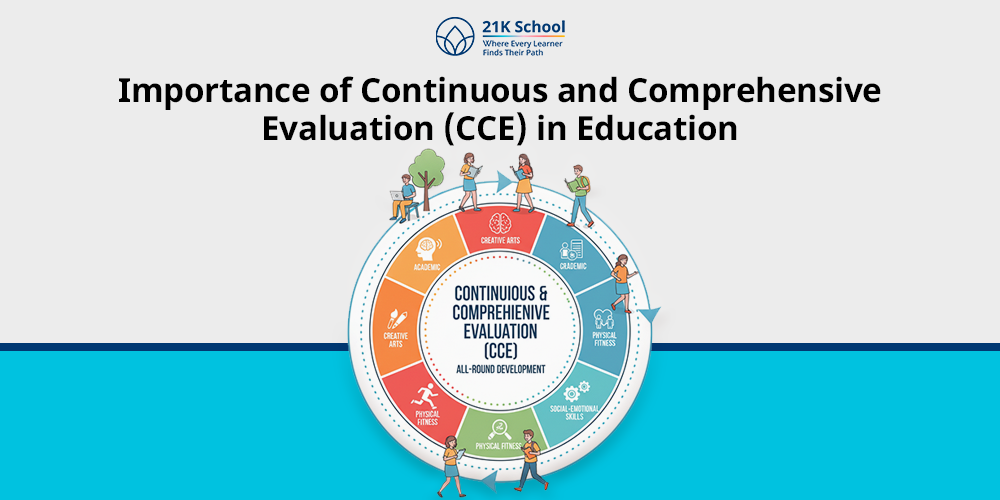
Learning with the IGCSE curriculum is a stepping stone to further education . However, parents are concerned about its grading system .
If you are someone looking for the same then you have landed the right way!
IGCSE , also popular as the International General Certificate of Secondary Education, is one of the most known and globally recognized qualifications.
While moving further you might have many questions. Question related to IGCSE curriculum, marksheet and results.
One of the most common questions among students and parents considering this curriculum is: “How does the IGCSE grading system work?”
But your curiosity will end here because we will discuss everything in one go.
Contents
- 1 What is IGCSE?
- 2 What IGCSE Grading System?
- 3 How Does The IGCSE Grading System Work?
- 4 Importance of the IGCSE Grading System
- 5 The IGCSE Grading System: Explained
- 6 Core vs. Extended Curriculum: How It Affects Grading
- 7 IGCSE v/s CBSE: Grading Systems Comparison
- 8 Common Misconceptions About IGCSE Grades
- 9 Tips to Achieve High Grades in IGCSE
- 10 Conclusion
What is IGCSE?

Before getting deeper let’s just understand what IGCSE is?
International General Certificate of Secondary Education or IGCSE, an academic program for learners specially between class 9th and 10th.
It is a 2 year International curriculum for kids to enhance their abilities and career growth. It includes different streams and subjects like science, commerce and languages.
There are two kinds of curriculum famous in IGCSE Core and extended curriculum. Both are different to meet student specific needs.
What IGCSE Grading System?

The IGCSE grading system is a powerful method of evaluating a learner’s academic performance.
With the IGCSE grading system one can calculate the exact result they have got in their previous exam. This can be done with the help of letter or numerical based format.
In simple words getting A* or 9 on the grading scale is the highest point and vice versa.
Further, we will elaborate each point for your better understanding and support. Before that let’s understand how the IGCSE grading system works.
How Does The IGCSE Grading System Work?

The IGCSE grading system works by evaluating the performance of learners in each subject.
It is based on school in different areas. Some use letter based grading like the old way and others use new grading systems such as numerical based.
Grading also depends on the subjects considering a single exam or exam plus practicals.
For example, subjects like Science include both theory and practical based paper. However, in English it may include classwork.
Importance of the IGCSE Grading System

For learners, the IGCSE grading system is a road map to academic success. Learners not only improve academics but also 21st century skills .
Here’s what you need to know about the IGCSE grading system:
- Pathway to Further Education: Pathway to further education means IGCSE opens the door where learners get the further opportunity for higher education with these grades.
- Student Motivation and Recognition: IGCSE grading system helps in student motivation and recognition by providing a structured framework for evaluating academic performance and offering pathways to future educational and career opportunities.
- Subject Selection: The IGCSE grading system is a helpful way that provides learners an open chance to choose what they want.
This means selection of streams and subjects are based on learners’ future goals, interest and strength.
The IGCSE Grading System: Explained

To know the IGCSE grading system in depth one needs to know each element denoted by alphabet and numbers.
Here’s a detailed information to understand the IGCSE grading system:
1. Old (letter-based) Grading System: A* to G
Old letter-based grading system is the traditionally used globally by many universities:
Here’s a more detailed breakdown:
| S.No. | Letter-based Grading | Meaning |
| 1. | A* | Highest grade, indicating exceptional performance. |
| 2. | A | Excellent performance. |
| 3. | B | Very good performance. |
| 4. | C | Good performance. |
| 5. | D | Satisfactory performance. |
| 6. | E | Sufficient performance. |
| 7. | F | Acknowledges some achievement, but below the minimum passing grade. |
| 8. | G | The lowest passing grade. |
| 9. | U | Ungraded, indicating the student did not meet the minimum standard for a passing grade. |
2. New 9–1 Grading System (optional, used in some regions)

New grading system mirrors the UK GCSE reform and is used by some international schools:
| S.No. | Number-based Grading | Meaning |
| 1. | 9 | Highest grade, equivalent to a high A*. |
| 2. | 8 | Equivalent to a low A* or high A. |
| 3. | 7 | Equivalent to a low A. |
| 4. | 6 | Equivalent to a high B. |
| 5. | 5 | Equivalent to a low B or high C. |
| 6. | 4 | Equivalent to a low C. |
| 7. | 3 | Equivalent to a D or high E. |
| 8. | 2 | Equivalent to a low E or high F. |
| 9. | 1 | Equivalent to a low F or G. |
| 10. | U | Ungraded. |
3. Grading Scale Comparison: A* = 9 or 8

Here’s a detailed grading scale comparison in letter-based grading and number-based grading:
| S.No. | Old System | New System |
| 1. | A* | 9 Or 8 |
| 2. | A | 7 |
| 3. | B | 6 |
| 4. | C | 5 Or 4 |
| 5. | D | 3 |
| 6. | E | 2 |
| 7. | F | 1 |
| 8. | G | 1 |
| 9. | U | U |
Core vs. Extended Curriculum: How It Affects Grading
Core and Extended Curriculum are two kinds of IGCSE grading, popular due to the its distinctive feature:
| S.No. | Particulars | Core Curriculum | Extended Curriculum |
| 1. | Target Audience: | The target audience who need to understand the subject may find it difficult. Here, learners aim to achieve grades C to G. | The target audience are students who are knowledgeable and have great depth and complexity. Here, learners aim to achieve grades A to E*. |
| 2. | Content: | It covers foundational knowledge. | It consists of all core content and other depth and complexity. |
| 3. | Grading: | Grades C to G. | Grades A to E*. |
| 4. | Limitations: | Taking Core restricts the maximum achievable grade to C. | Some universities prefer students with Extended level grades, especially for competitive courses. |
| 5. | Purpose: | The main purpose of this is to gain basic knowledge and skills for daily life. | It prepares students for competitive exams like A-Levels, IB, or university-level subjects. |
IGCSE v/s CBSE: Grading Systems Comparison
IGCSE has letter grading system includes A* to G or numerical grading system 9 to 1. Also, U for ungraded.
While CBSE uses A1 to E. Here you can see the breakdown of IGCSE v/s CBSE grading systems:
| Particulars | IGCSE | CBSE |
| Scale: | IGCSE grading system includes A* to G or 9 to 1. | CBSE includes 100 marks (converted to grades in board exams). |
| Focus: | The IGCSE mainly focuses on conceptual clarity, application-based learning. | CBSE focuses on theoretical and memory-based learning. |
| Assessment: | It includes coursework, practical and final exams. | Primarily final exams (except in practical subjects). |
Also, explore the comparison between IB vs IGCSE , IGCSE vs O-level , IGCSE vs A-Level .
Common Misconceptions About IGCSE Grades

For the IGCSE grading system students have various misconceptions. Here are some common misconceptions, one must aware of:
- Only A and A Grades Matter: Only A and A grades matter is a myth. Each point is crucial for grading. In reality, A grades are exceptional but consider a student’s overall performance and effort across all subjects is right.
- The IGCSE is Too Difficult: A lot of people have a myth that IGCSE exams are extremely difficult. Also, getting high marks is impossible. It’s not true that giving proper time to study, understand curriculum and schedule syllabus accordingly make it easy.
- IGCSE Grades are The Sole Determinant of Future Success: IGCSE grades are a crucial part of students’ education and are the sole determinant of future success. That’s not true. They get a flexible chance to retake exams if marks are less or unsatisfactory.
Understand whether IGCSE is accepted in Indian universities .
Tips to Achieve High Grades in IGCSE

To get high grades in IGCSE exams, learners need to understand the syllabus, create a balanced study plan, practice and use past guidelines.
Here’s a more detailed list for you:
- Understand the Syllabus and Exam Format: Start with understanding the IGCSE curriculum, syllabus and exam format while helping in making study routine especially in exam preparation.
- Create a Structured Study timetable: By creating a structured study timetable learners can break down big chapters into smaller bite size tasks and assign accordingly till exam.
- Practice Regularly and Strategically: Go with the timetable and schedule and practice regularly and strategically. This will ensure fulfillment of daily tasks without lacking.
- Active Learning Techniques: With the help of active learning techniques IGCSE grading system ensures growth in learning. It engages learners through various activities like discussion and investigation instead of passive learning.
- Seek Help and Support: Seek help and support when needed by parents, facilitators and elders if you have made any mistake or stuck in some difficult question etc.
Explore benefits of igcse board in India .
Conclusion
Hope with this blog you got all the answers of questions like What does an A* really mean? Is a grade 9 better than an A? And how do Core and Extended levels affect the final result?
The IGCSE grading system is a little bit confusing in initial days but understanding in detail helps learners, parents and teachers the rest of the time.
Reading this blog will help you to know everything in detail. To know more about IGCSE visit 21K School today.



